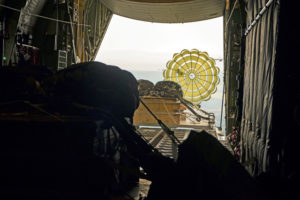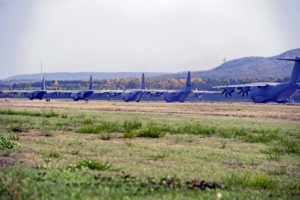
U.S. military personnel and aircraft assigned to Ramstein Air Base led an interfly formation over Germany, including aircraft from four NATO countries, Oct. 22.
The scenario included four C-130J Super Hercules aircraft assigned to the 86th Airlift Wing, one additional C-130J aircraft assigned to Ramstein, one C-130H Hercules aircraft from Belgium, one C-130H aircraft from the Netherlands, and one Airbus A400M Atlas aircraft from Germany. Three of the C-130Js assigned to Ramstein are also participating in the Aviation Detachment Rotation in Poland.
“The scenario is a combined joint tactical airlift formation enabling our NATO partners to fly in formation and conduct an aerial resupply to a common drop zone,” said Maj. Jonathan Cordell, 86th Operations Support Squadron weapons officer.
The event was a critical scenario in exercise Operation Varsity 20-04, a wing-wide exercise for the 86th Airlift Wing. Past iterations of the exercise have focused on testing different aspects of the mission at different locations. Leaders and planners took this iteration of the exercise to the next level by seamlessly including real-world missions, such as the interfly planned as a part of ADR in Poland.
“Airmen from the 86th Operations Group, 86th Maintenance Group and 86th Logistics Readiness Group generated the sortie and airdrop platforms within the construct of exercise OV 20-04,” Cordell said. “Their success demonstrates the Wing’s capability to deliver tactical airlift effects anywhere, anytime.”
Those involved in the planning and coordinating process demonstrated the ability to generate the tactical airlift scenario not only during an exercise mimicking a contested environment, but also through the challenge of communicating details with allies who speak different languages and follow different procedures.

“While the airlift mission capabilities are very similar across the board, mission planners were challenged to navigate details through various countries’ tactics, techniques and procedures,” Cordell said. “This was very important in ensuring the formation would be executed effectively and safely.”
U.S. Air Force training events enable participating units to learn from each other and better integrate in real-world scenarios. These formations serve multiple purposes, including building relationships that will improve the ability to respond to crises or contingencies together.
“Ultimately, (tactical formations) seek to strengthen international ties and improve our ability to provide airlift to the combined forces commander in the combined joint operating arena,” Cordell said.


